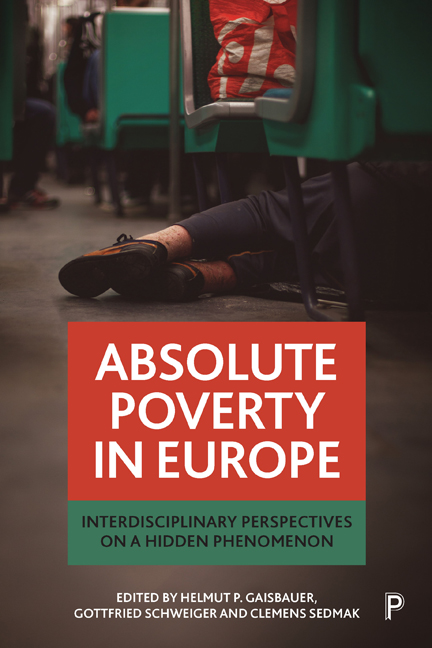Book contents
- Frontmatter
- Contents
- List of figures and tables
- Notes on contributors
- 1 Absolute poverty in Europe: introduction
- Part One Conceptual and methodological challenges
- Part Two Key issues for the absolute poor
- Part Three Policy responses to absolute poverty in Europe
- Part Four Ethical perspectives on absolute poverty in Europe
- Conclusion responding to the dark reality of absolute poverty in European welfare states
- Index
3 - Measures of extreme poverty applied in the European Union
Published online by Cambridge University Press: 27 April 2022
- Frontmatter
- Contents
- List of figures and tables
- Notes on contributors
- 1 Absolute poverty in Europe: introduction
- Part One Conceptual and methodological challenges
- Part Two Key issues for the absolute poor
- Part Three Policy responses to absolute poverty in Europe
- Part Four Ethical perspectives on absolute poverty in Europe
- Conclusion responding to the dark reality of absolute poverty in European welfare states
- Index
Summary
Introduction
The objective of this chapter is to operationalise and test out a number of possible measures of extreme poverty applied to the European Union countries, using the analysis of household survey data from EU Statistics on Income and Living Conditions (SILC). It is a revision and updating of two similar analyses undertaken by Bradshaw (2000 and 2001) and Bradshaw and Mayhew (2011), both undertaken for the European Commission. That work had been commissioned because of a dissatisfaction felt by some elements in the Commission with the measures of poverty that were being conventionally used in the European Union. So we start by reviewing developments in the conventional measurement of poverty in the EU. Then the concepts of absolute and extreme poverty are discussed. The bulk of the chapter presents the results of an analysis of the poverty rates, poverty gaps and poverty composition of five conceivable measures of extreme poverty.
These are:
• The World Bank dollar per day concept.
• Poverty thresholds based on national minimum income schemes – social assistance.
• A threshold set on the basis of a minimal reference budget standard.
• A severe deprivation standard.
• An overlaps measure based on severe deprivation and low income. The latter is the preferred option.
Conventional measures of poverty
Following the Lisbon European Council in 2000, the European Union was committed to fight against poverty and social exclusion using the Open Method of Coordination (OMC). A key element of the OMC was a set of indicators agreed upon jointly by the European Commission and all EU member states, in order to measure progress towards the agreed EU social inclusion objectives. At the 2001 Laeken European Council, 18 indicators were adopted.
Subsequently, the Social Protection Committee (SPC) and its Indicators Sub-Group (ISG) developed these. The main measure of monetary poverty included in the EU list of indicators is a relative one (net income less than 60% national median), known as the ‘at-risk-of-poverty’ rate. Since the EU Council of Ministers meeting in 1975, poverty in the EU has been conceived of as relative to a particular country at a particular time. There was and is strong justification for this approach rooted in social science understandings.
- Type
- Chapter
- Information
- Absolute Poverty in EuropeInterdisciplinary Perspectives on a Hidden Phenomenon, pp. 39 - 72Publisher: Bristol University PressPrint publication year: 2019



